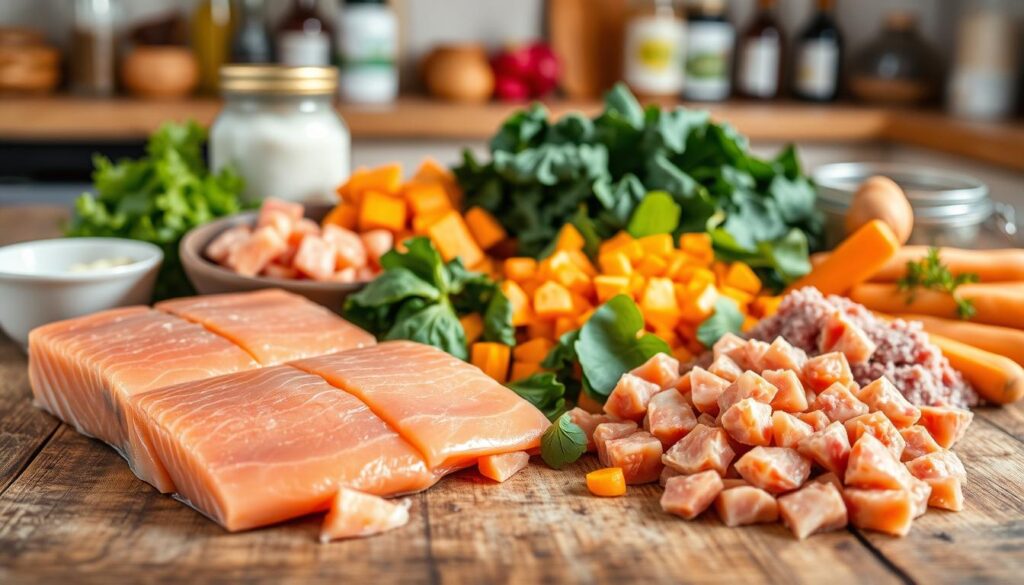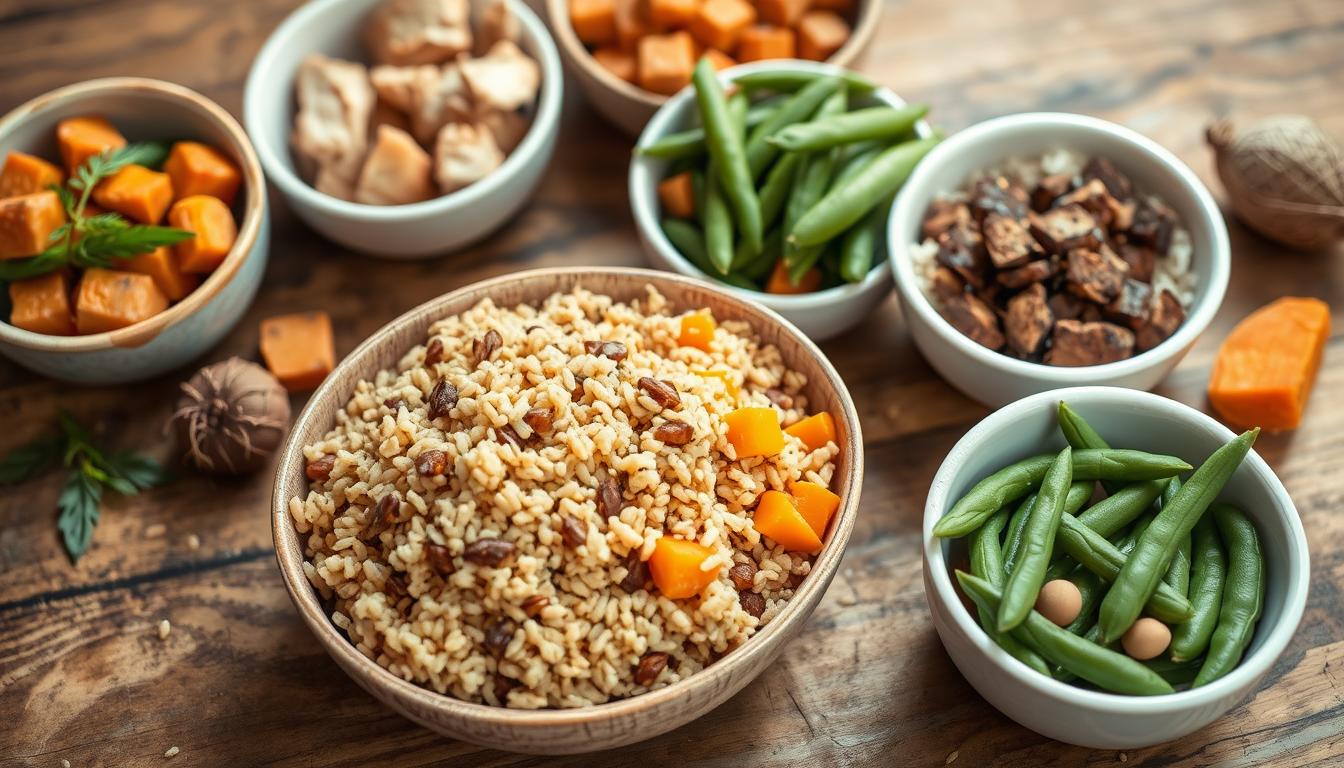Is your cat suffering from allergies? Switching to hypoallergenic recipes can be a game-changer. Many cats benefit from DIY hypoallergenic cat food, which can help alleviate allergy symptoms.
Preparing homemade hypoallergenic cat food lets you control what goes in. This ensures your cat gets the nutrients they need without allergens. This article will explore simple and healthy hypoallergenic recipes for cats you can make at home.
Key Takeaways
- Benefits of hypoallergenic diets for cats with allergies
- Simple ingredients for homemade hypoallergenic cat food
- Easy DIY recipes to alleviate allergy symptoms
- Nutritional considerations for hypoallergenic cat food
- Tips for transitioning your cat to a hypoallergenic diet
Understanding Cat Food Allergies
Cat food allergies are a big worry for pet owners. It’s key to know what causes them to help our cats feel better. Food allergies happen when a cat’s immune system reacts to something in their food.
This reaction can cause many symptoms. It’s important to find out what’s causing the allergy and remove it from their diet. Making homemade hypoallergenic cat food is a good way to do this. It lets owners pick the ingredients and lower the chance of an allergic reaction.
Common Allergens in Commercial Cat Foods
Commercial cat foods often have common allergens. These can make sensitive cats react. Some common allergens are:
- Beef
- Dairy
- Fish
- Wheat
- Soy
These ingredients are often found in commercial cat foods. It’s hard for cats with allergies to avoid them.
| Common Allergens | Symptoms |
|---|---|
| Beef, Dairy | Skin issues, itching |
| Fish, Wheat | Gastrointestinal problems |
| Soy | Ear infections, skin problems |
Signs Your Cat May Have Food Allergies
It can be hard to tell if a cat has food allergies. But there are signs to watch for. These include:
- Excessive scratching or grooming
- Skin lesions or hot spots
- Digestive issues, such as diarrhea or vomiting
- Ear infections
If your cat shows any of these signs, see a vet. They can help figure out the cause and find a solution.
Benefits of Homemade Hypoallergenic Cat Food Options
Homemade hypoallergenic cat food can change a cat’s life. It helps cats with food allergies feel better. Owners can pick what goes into their cat’s food.
Control Over Ingredients
Homemade cat food lets owners pick what’s in it. Commercial foods often have things like beef and soy that can make allergies worse. Owners can choose hypoallergenic protein sources and skip bad stuff.
Cost-Effectiveness
Homemade cat food can save money. Buying ingredients in bulk and planning meals helps. It also means fewer vet visits and less money spent on health issues.
Freshness and Quality
Homemade cat food is always fresh. It doesn’t have preservatives like commercial foods do. This means better digestion and a healthier coat for cats with allergies.
Essential Nutrients for Cats with Allergies
A good diet is key for cats with allergies. They need the right proteins, vitamins, and minerals. This helps them stay healthy and avoid bad reactions.
Protein Requirements
Cats need a lot of protein from animals. Use new proteins like venison, rabbit, or duck in their food. High-quality protein sources are very important.
Necessary Vitamins and Minerals
Cats also need vitamins and minerals. Vitamin A, Vitamin D, and minerals like calcium and phosphorus are important. They help keep the skin, coat, and body healthy. Make sure these are in the right amounts in their food.
| Nutrient | Function | Source |
|---|---|---|
| Vitamin A | Healthy Skin and Coat | Liver, Fish Oil |
| Calcium | Bone Health | Bone Meal, Dairy |
| Phosphorus | Energy Production | Meat, Fish |
The Importance of Taurine
Taurine is a special amino acid for cats. It helps their heart and eyes. Make sure they get enough taurine to stay healthy.
“Taurine is critical for feline heart health and vision. Ensuring adequate intake is essential for overall health.”
By focusing on these nutrients, you can make a healthy diet for your cat. This helps manage allergies and keeps them well.
Kitchen Equipment You’ll Need
When making homemade hypoallergenic cat food, you need some key kitchen tools. These tools help make the process easy and quick. They also keep your cat’s food fresh and good quality.
Basic Tools for Homemade Cat Food
To begin with allergy-free cat food recipes, you’ll need some basic tools. You’ll need a meat grinder or food processor to grind ingredients. Also, a mixing bowl and a measuring cup for mixing and measuring.
A slow cooker or Instant Pot is great for cooking the food. And, you’ll need knives and cutting boards to chop the ingredients.
Storage Containers and Recommendations
Storing your homemade cat food right is very important. Use airtight containers like glass or BPA-free plastic. Label them with the date and what’s inside.
Keep them in the fridge or freezer. For the freezer, use freezer-safe bags or containers to avoid freezer burn.
Single-Protein Hypoallergenic Cat Food Recipes
Hypoallergenic cat food recipes with one protein can ease allergy symptoms in cats. They are made to lower the chance of bad reactions. This makes them perfect for cats with sensitive stomachs or skin.
Turkey-Based Recipe
A turkey-based recipe is good for cats with allergies. Turkey is a new protein that’s less likely to cause an allergic reaction.
Ingredients
This recipe needs 1 pound of ground turkey, 1/4 cup of cooked brown rice, 1/4 cup of finely chopped carrots, and 1 teaspoon of fish oil.
Preparation Steps
First, heat your oven to 350°F (175°C). Mix the ground turkey, cooked brown rice, chopped carrots, and fish oil in a bowl. Shape into small patties and bake for 15-20 minutes, or until done. Let the patties cool before giving them to your cat.
Rabbit-Based Recipe
A rabbit-based recipe is another good choice for cats with food allergies. Rabbit meat is high in protein and low in fat, making it healthy.
Ingredients
You’ll need 1 pound of ground rabbit, 1/4 cup of cooked sweet potatoes, 1/4 cup of green beans, and 1 teaspoon of flaxseed oil.
Preparation Steps
Mix the ground rabbit, cooked sweet potatoes, green beans, and flaxseed oil in a bowl. Shape into small balls and steam for 10-15 minutes, or until done. Let them cool before serving.
Duck-Based Recipe
A duck-based recipe is a new protein diet for managing feline food allergies. Duck meat is a great source of protein and is often used in hypoallergenic diets.
Ingredients
You’ll need 1 pound of ground duck, 1/4 cup of cooked quinoa, 1/4 cup of steamed broccoli, and 1 teaspoon of salmon oil.
Preparation Steps
Mix the ground duck, cooked quinoa, steamed broccoli, and salmon oil in a bowl. Shape into small loaves and bake in a preheated oven at 350°F (175°C) for 20-25 minutes, or until done.
Novel Protein Recipes for Severely Allergic Cats
Severely allergic cats can greatly benefit from homemade hypoallergenic cat food options. These options use novel proteins. Novel proteins are new to your cat, so they’re less likely to cause an allergic reaction. Adding these proteins to your cat’s diet can help manage their allergies.
Venison Recipe
Venison is a novel protein that is rich in nutrients. It’s a great alternative for cats with severe allergies.
Ingredients
- 1 pound of venison
- 1/2 cup of cooked sweet potatoes
- 1/4 cup of green beans
- 1 teaspoon of fish oil
- 1 teaspoon of flaxseed oil
Preparation Steps
- Preheat your oven to 350°F (175°C).
- Place the venison on a baking sheet and bake for 30 minutes or until cooked through.
- Boil or steam the sweet potatoes and green beans until tender.
- Mix the cooked venison with sweet potatoes, green beans, fish oil, and flaxseed oil.
- Serve fresh or store in an airtight container in the refrigerator.
Quail Recipe
Quail is another novel protein that can be beneficial for cats with allergies. It’s lean and packed with essential nutrients.
Ingredients
- 1 pound of quail
- 1/2 cup of cooked carrots
- 1/4 cup of peas
- 1 teaspoon of coconut oil
- 1 teaspoon of turmeric powder
Preparation Steps
- Cook the quail in boiling water until fully cooked.
- Steam the carrots and peas until tender.
- Mix the cooked quail with carrots, peas, coconut oil, and turmeric powder.
- Serve immediately or refrigerate in an airtight container.

By adding these novel protein recipes to your cat’s diet, you can ease their allergy symptoms. You’ll also give them a healthier, more balanced diet.
Best Homemade Hypoallergenic Cat Food Options for Different Ages
Cats need different foods as they grow. Kittens, adults, and seniors all have unique needs. Making food that fits these needs helps keep them healthy and allergy-free.
Nutritional Needs for Kittens
Kittens need lots of protein and calories for growth. Using novel proteins like venison or duck is good. A kitten food recipe might have boiled chicken or turkey, green beans, and carrots, plus vitamins and minerals.
| Ingredient | Quantity | Nutritional Benefit |
|---|---|---|
| Boiled Chicken | 1 cup | High-quality protein |
| Cooked Green Beans | 1/2 cup | Rich in fiber and vitamins |
| Taurine Supplement | As directed | Essential for heart health |
Formulations for Adult Cats
Adult cats need a balance of protein, fat, and carbs. Avoiding common allergens is key. A salmon or rabbit-based recipe works well. Adding vegetables provides fiber and vitamins.
Considerations for Senior Cats
Senior cats need fewer calories but more joint support. Recipes for seniors can include glucosamine and chondroitin for joints. Using easily digestible proteins like turkey or chicken is best.
Customizing homemade cat food for your cat’s age ensures they get the right nutrients. This helps prevent allergies.
Grain-Free Hypoallergenic Options
Cats with food allergies might do well on grain-free diets. These diets avoid common allergens in regular cat food. They use new protein sources and carbs, making them safer for sensitive cats.
Why Grain-Free Matters for Some Cats
Grain-free diets help cats sensitive to wheat, corn, or soy. They cut down allergy risks. But remember, grain-free doesn’t mean hypoallergenic. The protein source is key for cats with allergies.
Vegetable Alternatives to Grains
Vegetables like sweet potatoes, pumpkin, and green peas are used in grain-free recipes. They add fiber and keep diets balanced. Choose veggies cats can easily digest to prevent problems.
Balanced Grain-Free Recipe
A good grain-free recipe might have venison or duck and sweet potato. For example, it could have 1 pound of venison, 1/2 cup of sweet potato, and 1/4 cup of green peas. Always check with a vet or nutritionist to make sure it’s right.
Homemade Hypoallergenic Cat Treats
For cats with sensitive skin or digestive issues, homemade hypoallergenic treats are a big help. They offer a safe snack and let owners pick the ingredients. This means they avoid common allergens.
Making these treats is easy and fun. Here are some ideas to start:
Freeze-Dried Meat Treats
Freeze-dried meat treats are full of protein. You can use meats like venison or duck. Slice the meat thin, freeze it, and then dry it out using a freeze dryer. Freeze-dried treats are safe and keep the meat’s natural nutrients.
Baked Fish Treats
Baked fish treats are a great choice. Use fish like salmon or cod, which are less likely to cause allergies. Mix the fish with hypoallergenic oil and bake until they’re crispy. These treats are full of omega-3 fatty acids, good for your cat’s skin and coat.
Catnip-Infused Hypoallergenic Treats
For cats that love catnip, you can make treats with it. Use a hypoallergenic flour and mix it with dried catnip. Bake into shapes and serve as a fun, safe snack.
| Treat Type | Main Ingredient | Benefits |
|---|---|---|
| Freeze-Dried Meat | Venison or Duck | High in protein, hypoallergenic |
| Baked Fish | Salmon or Cod | Rich in omega-3 fatty acids |
| Catnip-Infused | Hypoallergenic flour, Catnip | Fun, allergen-free snack |

Consulting with Your Veterinarian
Talking to a vet is key for making the best homemade cat food for allergies. They know what your cat needs to eat. A vet can give you great advice.
Importance of Professional Guidance
A vet is very important. They can find out what allergies your cat has. They can also check on your cat’s health and change the diet if needed.
Dr. Lisa Pierson, a vet and cat food expert, says, “A balanced diet is very important for cats with allergies. A vet can make sure the diet is right.”
Nutritional Supplements to Consider
Some supplements can help cats with allergies too. Omega-3 fatty acids can lessen swelling. Probiotics help with digestion. But, always check with a vet before adding supplements.
“The importance of omega-3 fatty acids in reducing inflammation cannot be overstated” says vet guidelines.
Working with your vet, you can make a special diet for your cat. This diet will help your cat stay healthy.
Conclusion
Homemade hypoallergenic cat food options can really help cats with food allergies. This article gives you a good start to make your cat’s food better. It’s all about taking care of your pet’s health and nutrition.
Making hypoallergenic recipes for cats at home lets you pick the right ingredients. You can avoid things that make your cat sick. This way, your cat gets what they need and you get closer to them.
Before you change your cat’s food, talk to your vet. They can help you make a diet plan that’s just right for your cat. This plan will consider your cat’s age, health, and how they live.
Choosing homemade hypoallergenic cat food options is a big step for your cat’s health. Start looking into hypoallergenic cat food today. Give your cat a happier, healthier life.
FAQ
What are the benefits of homemade hypoallergenic cat food?
Homemade cat food lets you pick what goes in it. This lowers allergy risks and keeps the food fresh.
How do I identify common allergens in commercial cat foods?
Look for beef, dairy, and soy in cat food labels. Talk to a vet to spot allergens.
Can I use homemade hypoallergenic cat food for kittens?
Yes, but make sure it’s balanced for kittens. A vet can help pick the right recipe.
What are some novel protein sources for cats with severe allergies?
Try venison, quail, or duck. These are good for cats with bad allergies.
How do I store homemade hypoallergenic cat food?
Keep it in airtight containers in the fridge or freezer. This keeps it fresh.
Are grain-free hypoallergenic cat food recipes suitable for all cats?
Grain-free might help some cats, but not all. Talk to a vet to see what’s best.
Can I add supplements to my homemade hypoallergenic cat food?
Yes, but check with a vet first. They’ll help pick the right supplements and amounts.
How often should I feed my cat homemade hypoallergenic cat food?
Feeding times vary by age, size, and needs. A vet can suggest the best schedule.




